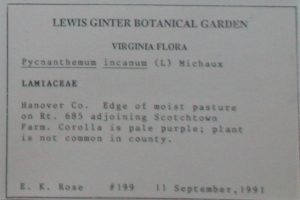Ginter Herbarium Steps Out
Lewis Ginter Botanical Garden’s collection of 4,000 herbarium specimens is now registered in the Index Herbariorum, a major international registry of herbarium plant collections. This means that our collection is now among over 3,000 registered herbaria around the world, where over 350 million plant records are cataloged, available for research and a crucial record of plant life over the past 400 years. The Index Herbariorum thus is a critical resource for understanding biodiversity science and conservation.
From the IH website:
The Index Herbariorum (IH) entry for an herbarium includes its physical location, URL, contents (e.g., number and type of specimens), founding date, as well as names, contact information and areas of expertise of associated staff. Only those collections that are permanent scientific repositories are included in IH. New registrants must demonstrate that their collection is accessible to scientists, and is actively managed. Each institution is assigned a permanent unique identifier in the form of a one to eight-letter code, a practice that dates from the founding of IH in 1935.
And now that we’re registered, we will endeavor to include our collection in the SERNEC (SouthEast Regional Network of Expertise and Collection herbarium digitization project that has been funded by the National Science Foundation. This is all very exciting and ultimately means that our herbarium collection may be accessible worldwide.
The Garden’s herbarium began in 1988 with our first director, Robert Hebb. He and his wife Winifred were avid plant collectors and believed a well-rounded botanical garden should include a herbarium. E. K. Rose, a volunteer at the Garden from 1990 until his death in 2012, was curator and primary collector for most of those years. In a 1996 profile, Rose described the collection as having an emphasis Virginia native plants found in Hanover, Henrico, Goochland, New Kent and Chesterfield counties. Specimens include plants considered weeds, and rare or little-known specimens of ferns, vines, trees, and wetland species. Rose believed a herbarium is a resource for studies of the local flora, horticulture, and general taxonomy and systematics (plant naming and divisions into natural gro ups). He believed that herbaria provide a visual foundation for training in and exposure to plant diversity.
ups). He believed that herbaria provide a visual foundation for training in and exposure to plant diversity.
The Garden looks forward to having the collection included in the National Science Foundation project and sharing our local plant diversity with the world.
Each specimen is numbered and has a descriptive card.
